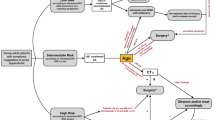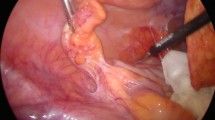Abstract
Background
The reported negative appendicectomy rate for young women remains high. This high rate of unnecessary appendicectomies has morbidity and high cost. Consensus European Association of Endoscopic Surgeons (EAES) guidelines have emphasised the value of routine laparoscopy as a diagnostic tool in young women. The objective of this study is to investigate the role of routine laparoscopy in the diagnosis of suspected appendicitis in young women.
Methods
The details of young female patients who have had an appendicectomy with or without laparoscopy between 1980 and 2005 were obtained. The histopathological reports pertaining to the episode of appendicectomy were manually searched. Three periods were identified for comparison. The first period was between 1980 and 1990 when diagnostic laparoscopy was not practised in the emergency setting. The second period was between 1991 and 1999 when diagnostic laparoscopy was used selectively. The third period was between 2000 and 2005 when diagnostic laparoscopy was used routinely to investigate female patients presenting with acute right iliac fossa pain.
Results
Selective laparoscopy reduced the rate of negative appendicectomy rate from 37% to 31% (ns). By contrast, routine laparoscopy reduced the negative appendicectomy rate to 5% (p < 0.005). Additionally, considering the ratios of all appendectomies to normal appendices, an average of one in three appendices excised was normal before the era of laparoscopy. The selective use of laparoscopy did not significantly alter this ratio (ns). By contrast routine use of laparoscopy has altered the ratio to 1 in 20 appendices removed to be normal (p < 0.001).
Conclusion
In young females, diagnostic laparoscopy used selectively reduces the rate of negative appendicectomy but not significantly. However, when used routinely, laparoscopy significantly reduces the rate of negative appendicectomy. Diagnostic laparoscopy should be used routinely for all young females presenting with right iliac fossa pain sufficiently severe to warrant surgical exploration.

Similar content being viewed by others
References
Kang JY, Hoare J, Majeed A, Williamson RC, Maxwell JD (2003) Decline in admission rates for acute appendicitis in England. Br J Surg 90(12):1586–1592
Borgstein PJ, Gordijn RV, Eijsbouts QAJ, Cuesta MA (1997) Acute appendicitis—a clear-cut case in men, a guessing game in young women. Surg Endosc 11:923–927
McDonald GP, Pendarvis DP, Wilmoth R, Daley BJ (2001) Influence of preoperative computed tomography on patients undergoing appendectomy. Am Surg 67(11):1017–1021
Weyant MJ, Eachempati SR, Maluccio MA, Rivadeneira DE, Grobmyer SR, Hydo LJ, Barie PS (2000) Interpretation of computed tomography does not correlate with laboratory or pathologic findings in surgically confirmed acute appendicitis. Surgery 128(2):145–152
Jones PF (2001) Suspected acute appendicitis: trends in management over 30 years. Br J Surg 88(12):1570–1577
Flum DR, Morris A, Koepsell T, Dellinger EP (2001) Has misdiagnosis of appendicitis decreased over time? A population-based analysis. JAMA 286(14):1748–1753
Korner H, Soreide JA, Pedersen EJ, Bru T, Sondenaa K, Vatten L (2001) Stability in incidence of acute appendicitis. A population-based longitudinal study. Dig Surg 18(1):61–66
Andersson RE, Hugander A, Thulin AJ (1992) Diagnostic accuracy and perforation rate in appendicitis: association with age and sex of the patient and with appendicectomy rate. Eur J Surg 158:37–41
Chang Fc, Hogle HH, Welling DR (1973) The fate of the negative appendix. Am J Surg 126:752–754
Flum DR, Koepsell T (2002) The clinical and economic correlates of misdiagnosed appendicitis—Nationwide analysis. Arch Surg 137:799–804
van Dalen R, Bagshaw PF, Dobbs BR, Robertson GM, Lynch AC, Frizelle FA (2003) The utility of laparoscopy in the diagnosis of acute appendicitis in women of reproductive age. Surg Endosc 17(8):1311–1313. Epub 2003 May 13
Larsson PG, Henriksson G, Olsson M, Boris J, Stroberg P, Tronstad SE, Skullman S (2001) Laparoscopy reduces unnecessary appendicectomies and improves diagnosis in fertile women. A randomized study. Surg Endosc 15(2):200–202
Vander Velpen GC, Shimi SM, Cuschieri A (1994) Diagnostic yield and management benefit of laparoscopy: a prospective audit. Gut 35:1617–1621
Bijnen CL, van den Broek WT, Bijnen AB, de Ruiter P, Gouma DJ (2003) Implications of removing a normal appendix. Dig Surg 20(3):215–219; discussion 220–221
Sauerland S, Agresta F, Bergamaschi R et al (2006) Laparoscopy for abdominal emergencies: Evidence-based guidelines of the European Association for Endoscopic Surgery. Surg Endosc 20:14–29
Slim K, Chipponi J (2006) Laparoscopy for every acute appendicitis? Letter to the Editor. Surg Endosc 20:1785–1786
Sauerland S, Neugebauer E (2007) Laparoscopy for every acute appendicitis? The authors reply. Surg Endosc 21:342
Jadallah A, Abdul-Ghani A, Tibblin S (1994) Diagnostic laparoscopy reduces unnecessary appendicectomy in fertile women. Eur J Surg 160:41–45
Laine S, Rantala A, Gullichsen R, Ovaska J (1997) Laparoscopic appendectomy—is it worthwhile? A prospective, randomized study in young women. Surg Endosc 11:95–97
Olsen JB, Myren CJ, Haahr PE (1993) Randomised study of the value of laparoscopy before apppendicectomy. Br J Surg 80:922–923
Terasawa T, Blackmore CC, Bent S, Kohlwes RJ (2004) Systematic review: computed tomography and ultrasonography to detect acute appendicitis in adults and adolescents. Ann Intern Med 141:537–546
Andersson RE (2004) Meta-analysis of the clinical and laboratory diagnosis of appendicitis. Br J Surg 91(1):28–37
Kane MG, Krejs GL (1984) Complications of diagnostic laparoscopy in Dallas. Gastrointest Endosc 30:237–240
Puylaret JB, Rutgers PH, Lalisang RI et al (1987) A prospective study of ultrasonography in the diagnosis of appendicitis. N Eng J Med 317(11):666–669
Wong SK, Chan LP, Yeo A (2002) Helical CT imaging of clinically suspected appendicitis: correlation of CT and histological findings. Clin Radiol 57(8):741–745
Perez J, Barone JE, Wilbanks TO, Jorgensson D, Corvo PR (2003) Liberal use of computed tomography scanning does not improve diagnostic accuracy in appendicitis. Am J Surg 185(3):194–197
Author information
Authors and Affiliations
Corresponding author
Rights and permissions
About this article
Cite this article
Garbarino, S., Shimi, S.M. Routine diagnostic laparoscopy reduces the rate of unnecessary appendicectomies in young women. Surg Endosc 23, 527–533 (2009). https://doi.org/10.1007/s00464-008-9855-6
Received:
Revised:
Accepted:
Published:
Issue Date:
DOI: https://doi.org/10.1007/s00464-008-9855-6




